Battling Marek's disease in chickens. How to spot it and what to do about it.

Marek’s disease is a highly contagious viral disease of poultry. It is also known as Range Paralysis, Skin Leucosis, Neural Leucosis, Neural Lymphomatosis, or Pearl Eye diseases.
Table of Contents
Marek's disease (MD) is a tumour-causing viral disease of chickens of the Herpesvirus family.
Although Marek's disease has been effectively controlled by vaccine, sporadic and sometimes serious losses still continue to occur from it.
Below: Leg paralysis caused by Marek's disease. Birds often drop their wind to stabilise themselves or sit back.
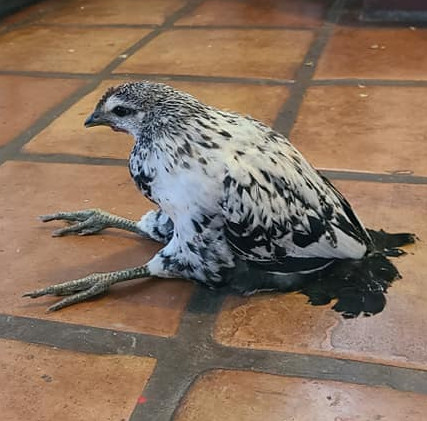
It is characterised by marked enlargement of the nerves, liver, spleen, and kidneys due to diffuse growth of certain cells. Birds exhibit classic symptoms including paralysis, cloudy eyes, dropped wings and death.
Understanding Marek's disease:
Chickens are the most important natural host and Marek's is very rare and probably of no real importance in other species except for quail.
Chickens of 12 to 24 weeks of age are most susceptible to Marek's disease and generally, it rarely occurs in chickens below 6 weeks of age or above 35 weeks of age except in backyard flocks where it may be endemic.
Marek’s disease is a lymphoproliferative, highly contagious disease of poultry caused by a high cell-associated galled herpes virus, a DNA virus belonging to the Herpesvirus family.
There are three serotypes of the virus recognised. The virus remains stable for about 24 hours at 30°C.
Marek's is found on every continent where there are chickens.
Outbreaks of Marek's disease are rare in vaccinated commercial flocks but are responsible for 5 to 8% of the deaths in backyard chickens.
Backyard flocks are not routinely vaccinated against Marek's.
Below: Incidents of Marek’s disease in chickens as a percentage of diagnosable submissions to the Great Britain scanning surveillance network, from 2010 to 2021.
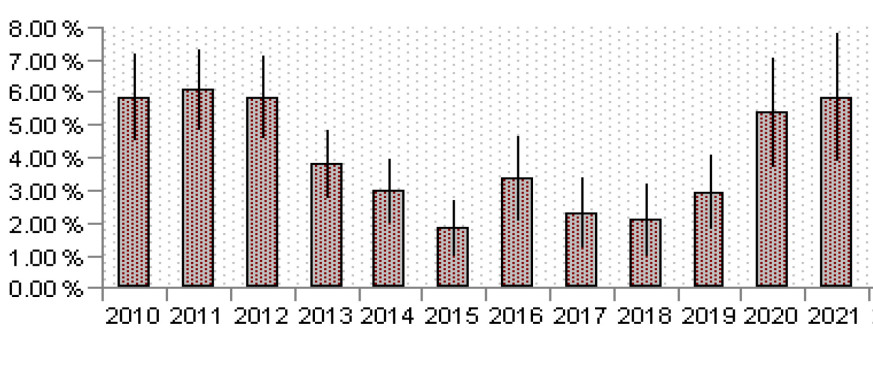
Source: Animal and Plant Health Agency. Contains public sector information licensed under the Open Government Licence v3.0.
Below: We also know the incidence of Marek's disease in chickens is on the increase. This graph show data from 2017 to 2021.
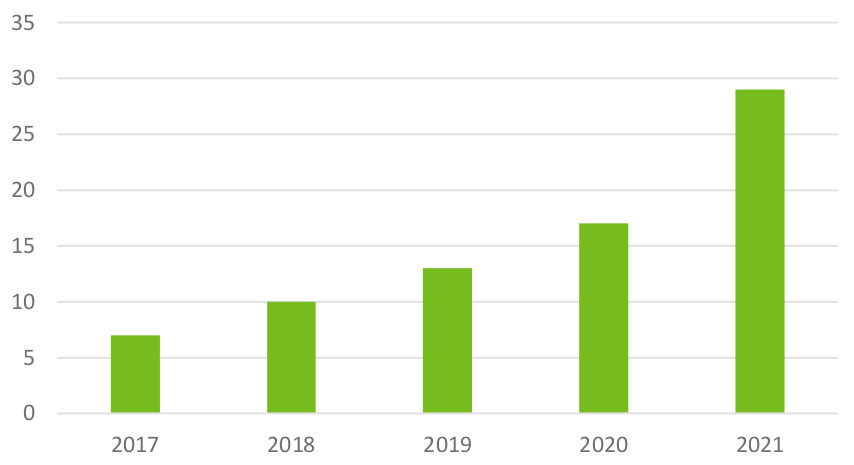
Source: Animal and Plant Health Agency. Contains public sector information licensed under the Open Government Licence v3.0.
This disease exists in poultry producing countries throughout the world. The mode of transmission of this disease is through the inhalation of infected material from the environment.
Marek's Disease is primarily transmitted through airborne particles, making it highly contagious. Infected birds shed the virus through feather follicles, dander, and even saliva. This means that even if one chicken in your flock is infected, the entire group could be at risk.
The virus particles can persist for a considerable period in the dandruff of feather follicles, which are released in the environment. The infected materials are oral, nasal, tracheal secretions, and litter materials. The darkling beetle (Alphitribus diaperinus) is acting as a mechanical transmitter of the disease.
Marek's disease can be spread through the following ways:
- From one chicken to another chicken through dander.
- Spread by an infected air.
- It can be spread from the old infected flock to chicken through remnants left behind.
- By a Keeper through infected clothes and shoes.
- By a Wild Birds.
A report by Józef Marek, distributed in 1907, of paresis in 4 chickens is the first account of the disease that was named after him. Afterwards, outbreaks were accounted for as early as 1914 in the USA, and in this way in many different nations.
Chickens get between the age of 3 and 35 weeks as a rule. It can be later in backyard flocks.
Most chickens become infected with Marek’s disease virus during the first few weeks of life than carry the infection throughout their lives, often without developing the overt disease.
Marek's disease is highly contagious and the virus spreads rapidly from infected to uninfected birds. Cells from the feather follicles are the most important source of infection. The virus is present in a free form in cells shed from the feather follicles.
Inhalation through the respiratory tract is the most important route of infection.
Once contracted, the infection persists throughout the life of the chicken, and infected birds continue to contaminate the environment by shedding the virus. Continued shedding of the virus by infected birds and hardiness of the virus are responsible for prevalence of the infection.
The virus survives for months and possibly years under the right conditions outside the birds. This makes it very difficult to eradicate.
The symptoms of Marek's disease:
Symptoms of Marek's disease include limb paralysis, irregularly shaped pupils, light-sensitivity, and grey cloudy eyes, dropped wings and skin around feather follicles maybe raised and roughened.
Below: Wing paralysis may involve one or both wings to variable degrees.
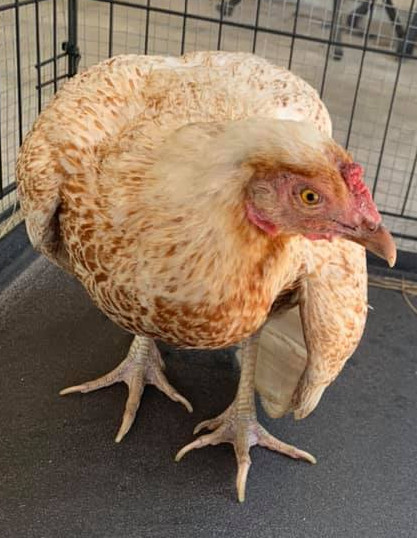
The outcome is fatal with chickens usually dying from starvation, as they are unable to acquire water and food. A chicken with Marek’s often ‘wastes away’ very quickly.
Marek's disease progresses fast after the onset of symptoms. A chickens will generally either die within 24 to 72 hours or recover to some extent.
Marek's Disease can cause more signs similar to other diseases as it weakens the bird's immunity putting it more at risk of other infections.
The incubation period of Marek's varies considerable between 14 days and 12 weeks.
Neurologic signs in Marek's disease may include torticollis, a condition in which the head becomes persistently turned to one side or twisted back over the body, is often associated with painful muscle spasms and paralysis in the legs, wings and neck are painful conditions.
Weight loss, collapsed crop and the inability to feed and drink are distressing for chickens.
The incubation period ranges from 3 weeks to 9 weeks. The disease appeared in several forms:
Classical or Neural form:
- Birds of 16-20 weeks of age usually suffer.
- Signs are mostly concerned with the affection of nerves.
- Paralysis of legs and dropping wings.
- Nerves like sciatic nerve, brachial nerve, celiac, and vagus nerve running through neck, thoracic, and abdominal viscera are affected.
- Birds are unable to stand to remain in the recumbent position, legs and wings may be stretched in either direction. The “split leg” stance is the usual feature.
- The mortality rate is comparatively low and mostly noted at the onset of maturity.
The acute or visceral form:
- Generally, birds at the ages of 3-4 weeks are affected.
- Internal organs of the birds are affected.
- Depression, droopiness, unthriftiness, dehydration, emaciation, and anaemia.
- The mortality rate may go as high as 60 %.
- Chicks may die suddenly without showing any clinical manifestations.
- Ovaries of the affected layers and pullets look like a cauliflower.
The transitional and paralytic form:
- Occurs in chicken at the age of 5-18 weeks of age.
- Sudden development of paresis and paralysis of the legs, wings, and neck.
- Signs usually disappear within 24-48 hours.
Ocular form:
- Blindness in the birds due to mononuclear cell infiltration in the iris causing “grey eye” or “pearl eye”.
Skin and a cutaneous form:
- Distinct white nodules on the skin of the chicken.
- In extreme cases looks like brownish nodules.
Muscular form:
- Superficial and deep muscles like the pectoral muscle of the chicken affected.
- Muscles look lustreless and whitish grey.
- There are tiny white streaks to nodular tumours in the muscles.
Highly pathogenic Viral Marek's Disease strains are liable for acute outbreaks of mortality which may achieve 50% or 60% in exposed, non-vaccinated flocks. Generally, erosive losses of up to 20% happen in non-secured or poorly immunised flocks. Losses of around 1% can be expected in vaccinated flocks.
Marek's disease virus is an immunosuppressive and infected broiler and pullet substitution flocks are vulnerable to a wide range of viral and bacterial diseases. Uncovered broiler shows expanded mortality and condemnation rates at processing.
With Mareks as many as 6 in every 10 birds will die and many others will get secondary infections or become unthrifty as a result.
Diagnosing Marek's disease:
Diagnosis is based on the characteristic postmortem findings, the markedly enlarged liver and spleen, and the presence of tumours in various other internal organs.
Specimens to be collected include: Skin, dander, feather tips of infected chicken, blood.
Based on the clinical sign and postmortem lesion or Serological Test.
Lesions of Marek’s disease:
- Affected nerves thickened to more than 2-3-time than the normal.
- Striation and glistering appearance of the nerve is lost and looks oedematous.
- Celiac, cranial, mesenteric, brachial, and sciatic plexes, and greater splanchnic nerves are mostly affected.
- Tiny whitish streaks to nodular tumours in muscles.
- Atrophy of bursa of the chicken.
- In females, ovary look cauliflower-like appearance.
- Pale, single, or multiple nodular tumours in the myocardium.
- The skin has whitish nodules, scab with a brownish colour.
Some strains and breeds have a genetic resistance to Marek's.
More susceptible breeds include Polish, Silkies and Sebrights while less susceptible breeds are Egyptians Fayoumis, White Leghorns and the Icelandic.
How is Marek's disease treated in chickens?
There is no satisfactory treatment of Marek’s disease virus.
If you notice signs of the disease, see a veterinarian for the confirmation as sometimes paralysis also occurs due to injury.
If the disease is confirmed than isolate the healthy chickens and cull the diseased birds.
Once a bird has been infected, even if it overcomes the initial infection it goes on to shed virus laden dander everywhere it goes for the rest of it's life.
Below: There is no treatment, only prevention.
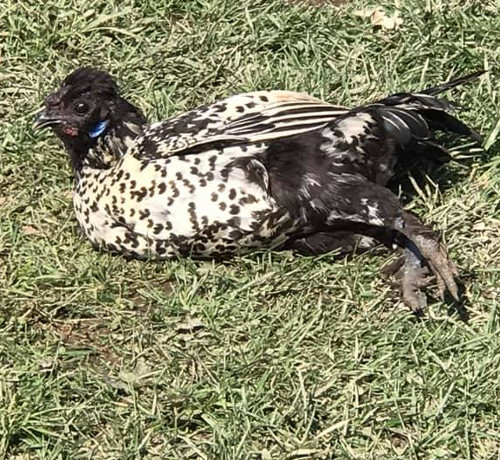
Once the virus is introduced into the shed it can be spread very quickly from infected chicken to healthy chicken and infected chicken shed virus continuously. It is difficult to recover once the bird affected by Marek’s disease. In layers it affects oviduct by causing tumours to ovary and depresses laying and hatch-ability.
Humans can not catch Marek’s from chickens or poultry.
There is no zoonotic importance of Marek’s disease. It means this disease not transferred to humans and other mammals.
Meat and egg from the infected chicken are not affected by the disease and safe to eat for humans. However, if a chicken is infected with the cutaneous form of Marek’s disease, it may have skin or internal tumours that can be unsightly.
Prevention of Marek's disease in chickens?
Prevention and control includes Vaccination, Bio-security, and genetic resistance.
When introducing new birds into the flock, I've started a quarantine period to monitor their health before integrating them. This helps prevent the introduction of infected birds.
Over the years I have been more strict when it comes to biosecurity measures, including disinfecting equipment, regularly cleaning coops, and limiting visitor access to my chicken area. These steps reduce the risk of the virus entering my flock.
Vaccination is the most effective way to prevent Marek's Disease. Marek’s vaccine should only be given to healthy one-day-old baby chicks and you may need to have it done by a vet or qualified practitioner.
You can vaccinate older birds, but the vaccination will have no effect if they've been exposed at all to the actual virus. If your chickens have reached 35 weeks of age then vaccinating is probably pointless.
If the Marek's vaccine is a live vaccine and it does make your bird a carrier of that strain which can infect other birds. This is not a problem as all it does in confer immunity to the other birds with a strain of the virus that has no detrimental effects to the chickens.
Vaccinating your chicks will help eradicate this horrible disease. My avian vet say he sees Marek's all the time in small flocks and he highly recommends that you get chicks that have been vaccinated.
